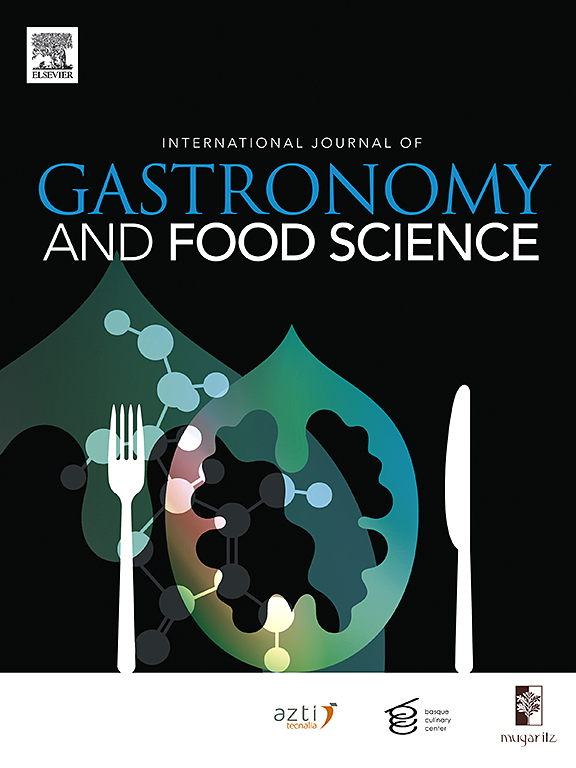明胶棉花糖:制造功能性纤维食品的模型研究
IF 3.2
2区 农林科学
Q2 FOOD SCIENCE & TECHNOLOGY
International Journal of Gastronomy and Food Science
Pub Date : 2025-03-15
DOI:10.1016/j.ijgfs.2025.101168
引用次数: 0
摘要
棉花糖独特的质地和快速融化的特性使其成为探索变革性食品技术的引人注目的模型。在这项研究中,我们开发了一种基本的方法,生产棉花糖样纤维使用明胶溶液的创新食品设计。采用改良的棉花糖机在控制条件下对明胶溶液进行加工,考察了酸(乙酸、柠檬酸)和蔗糖等添加剂对明胶纤维形成的影响。结果表明,可以通过调节溶液粘度来控制纤维的厚度。酸可以降低粘度,使纤维更柔软、更细,而蔗糖可以增加粘度,使纤维更厚、更结实。验证了描述纤维厚度与溶液粘度关系的标度定律。该研究为设计具有定制物理化学特性的纤维食品结构提供了见解,从而在功能食品,分子烹饪和个性化营养方面得到了应用。本文章由计算机程序翻译,如有差异,请以英文原文为准。
Gelatin Cotton Candy: A model study to create functional fiber foods
Unique texture of cotton candy and rapid melting behavior make it a compelling model for exploring transformative food technologies. In this study, we develop a fundamental method for producing cotton candy-like fibers using gelatin solutions for innovative food design. Gelatin solutions were processed under controlled conditions using a modified cotton candy machine, and the effects of additives such as acids (acetic and citric acid) and sucrose on fiber formation were investigated. The results demonstrated that the fiber thickness could be controlled by adjusting the solution viscosity. Acids reduced viscosity, yielding softer and thinner fibers, while sucrose in-creased viscosity, resulting in thicker and firmer fibers. A scaling law de-scribing the relationship between fiber thickness and solution viscosity was validated. This study provides insights into designing fiber food textures with tailored physico-chemical properties, leading to applications in functional foods, molecular gastronomy, and personalized nutrition.
求助全文
通过发布文献求助,成功后即可免费获取论文全文。
去求助
来源期刊

International Journal of Gastronomy and Food Science
Social Sciences-Cultural Studies
CiteScore
5.30
自引率
10.50%
发文量
170
审稿时长
45 days
期刊介绍:
International Journal of Gastronomy and Food Science is a peer-reviewed journal that explicitly focuses on the interface of food science and gastronomy. Articles focusing only on food science will not be considered. This journal equally encourages both scientists and chefs to publish original scientific papers, review articles and original culinary works. We seek articles with clear evidence of this interaction. From a scientific perspective, this publication aims to become the home for research from the whole community of food science and gastronomy.
IJGFS explores all aspects related to the growing field of the interaction of gastronomy and food science, in areas such as food chemistry, food technology and culinary techniques, food microbiology, genetics, sensory science, neuroscience, psychology, culinary concepts, culinary trends, and gastronomic experience (all the elements that contribute to the appreciation and enjoyment of the meal. Also relevant is research on science-based educational programs in gastronomy, anthropology, gastronomic history and food sociology. All these areas of knowledge are crucial to gastronomy, as they contribute to a better understanding of this broad term and its practical implications for science and society.
 求助内容:
求助内容: 应助结果提醒方式:
应助结果提醒方式:


